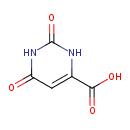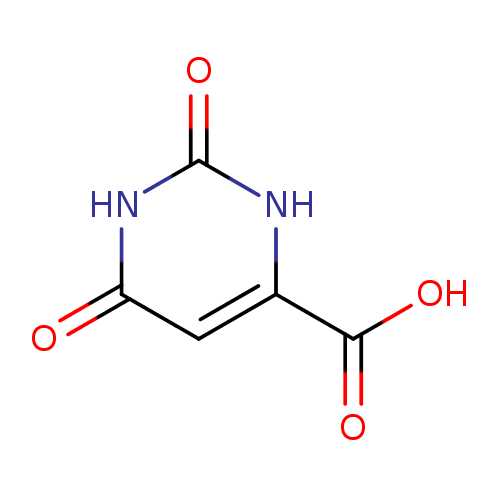|
Record Information |
|---|
| Version |
1.0 |
|---|
| Update Date |
1/22/2018 12:54:54 PM |
|---|
|
Metabolite ID | PAMDB110851 |
|---|
|
Identification |
|---|
| Name: |
orotate |
|---|
| Description: | Orotic acid is a minor dietary constituent. Indeed, until it was realized that it could be synthesized by humans, orotic acid was known as vitamin B-13. The richest dietary sources are cow's milk and other dairy products as well as root vegetables such as carrots and beets. Dietary intake probably contributes to a basal rate of orotic acid excretion in urine because fasting decreases excretion by ~50%. However, it is now apparent that most urinary orotic acid is synthesized in the body, where it arises as an intermediate in the pathway for the synthesis of pyrimidine nucleotides. Orotic acid is converted to UMP by UMP synthase, a multifunctional protein with both orotate phosphoribosyltransferase and orotidylate decarboxylase activity. The most frequently observed inborn error of pyrimidine nucleotide synthesis is a mutation of the multifunctional protein UMP synthase. This disorder prevents the conversion of orotic acid to UMP and thus to other pyrimidines. As a result, plasma orotic acid accumulates to high concentrations, and increased quantities appear in the urine. Indeed, urinary orotic acid is so markedly increased in individuals harboring a mutation in UMP synthase that orotic acid crystals can form in the urine. The urinary concentration of orotic acid in homozygotes can be of the order of millimoles per millimole creatinine. By comparison, the urinary level in unaffected individuals is ~ 1 umol/mmol creatinine. (PMID: 17513443 ). |
|---|
|
Structure |
|
|---|
| Synonyms: | |
|---|
|
Chemical Formula: |
C5H3N2O4
|
|---|
| Average Molecular Weight: |
155.09 |
|---|
| Monoisotopic Molecular
Weight: |
156.0171066272 |
|---|
| InChI Key: |
PXQPEWDEAKTCGB-UHFFFAOYSA-M |
|---|
| InChI: |
InChI=1S/C5H4N2O4/c8-3-1-2(4(9)10)6-5(11)7-3/h1H,(H,9,10)(H2,6,7,8,11)/p-1 |
|---|
| CAS
number: |
65-86-1 |
|---|
| IUPAC Name: | 2,6-dioxo-1,2,3,6-tetrahydropyrimidine-4-carboxylate |
|---|
|
Traditional IUPAC Name: |
orotic acid |
|---|
| SMILES: | C1(=C(C([O-])=O)NC(NC(=O)1)=O) |
|---|
|
Chemical Taxonomy |
|---|
|
Taxonomy Description | This compound belongs to the class of organic compounds known as pyrimidinecarboxylic acids. These are pyrimidines with a structure containing a carboxyl group attached to the pyrimidine ring. |
|---|
|
Kingdom |
Organic compounds |
|---|
| Super Class | Organoheterocyclic compounds |
|---|
|
Class |
Diazines |
|---|
| Sub Class | Pyrimidines and pyrimidine derivatives |
|---|
|
Direct Parent |
Pyrimidinecarboxylic acids |
|---|
| Alternative Parents |
|
|---|
| Substituents |
- Hydropyrimidine carboxylic acid derivative
- Pyrimidine-6-carboxylic acid
- Pyrimidone
- Hydropyrimidine
- Vinylogous amide
- Heteroaromatic compound
- Lactam
- Urea
- Carboxylic acid derivative
- Monocarboxylic acid or derivatives
- Carboxylic acid
- Azacycle
- Organic oxide
- Organopnictogen compound
- Organooxygen compound
- Organonitrogen compound
- Organic oxygen compound
- Organic nitrogen compound
- Hydrocarbon derivative
- Aromatic heteromonocyclic compound
|
|---|
| Molecular Framework |
Aromatic heteromonocyclic compounds |
|---|
| External Descriptors |
|
|---|
|
Physical Properties |
|---|
| State: |
Solid |
|---|
| Charge: | -1 |
|---|
|
Melting point: |
345.5 °C |
|---|
| Experimental Properties: |
| Property | Value | Reference |
|---|
| Melting Point | 345.5 °C | Not Available | | Boiling Point | Not Available | Not Available | | Water Solubility | 1.82 mg/mL at 18 °C | Not Available | | LogP | -0.83 | SANGSTER (1994) |
|
|---|
| Predicted Properties |
|
|---|
|
Biological Properties |
|---|
| Cellular Locations: |
Not Available |
|---|
| Reactions: | |
|---|
|
Pathways: |
|
|---|
|
Spectra |
|---|
| Spectra: |
| Spectrum Type | Description | Splash Key | |
|---|
| GC-MS | GC-MS Spectrum - GC-EI-TOF (Pegasus III TOF-MS system, Leco; GC 6890, Agilent Technologies) | splash10-0udi-1982000000-b20f2ec9a2f1acc84ae1 | View in MoNA |
|---|
| GC-MS | GC-MS Spectrum - GC-MS (3 TMS) | splash10-0zfr-2693000000-07bf11b5177412647d9b | View in MoNA |
|---|
| Predicted GC-MS | Predicted GC-MS Spectrum - GC-MS | Not Available |
|---|
| LC-MS/MS | LC-MS/MS Spectrum - Quattro_QQQ 10V, Negative (Annotated) | splash10-03di-0900000000-81d73aed73c250fff3ae | View in MoNA |
|---|
| LC-MS/MS | LC-MS/MS Spectrum - Quattro_QQQ 25V, Negative (Annotated) | splash10-0006-9300000000-ecb08d1854a2789480d1 | View in MoNA |
|---|
| LC-MS/MS | LC-MS/MS Spectrum - Quattro_QQQ 40V, Negative (Annotated) | splash10-0006-9100000000-15748a4c13636c42f4f9 | View in MoNA |
|---|
| LC-MS/MS | LC-MS/MS Spectrum - LC-ESI-QTOF (UPLC Q-Tof Premier, Waters) , Positive | splash10-02ti-4900000000-6fd6312d81f94faaaf11 | View in MoNA |
|---|
| LC-MS/MS | LC-MS/MS Spectrum - LC-ESI-QTOF (UPLC Q-Tof Premier, Waters) , Negative | splash10-03di-0900000000-1b7abf52e4a01cb85541 | View in MoNA |
|---|
| Predicted LC-MS/MS | Predicted LC-MS/MS Spectrum - 10V, Positive | splash10-0bt9-0900000000-1ad59feda583f2247b21 | View in MoNA |
|---|
| Predicted LC-MS/MS | Predicted LC-MS/MS Spectrum - 20V, Positive | splash10-03di-2900000000-0d0d27215e9f39a2a15b | View in MoNA |
|---|
| Predicted LC-MS/MS | Predicted LC-MS/MS Spectrum - 40V, Positive | splash10-0006-9100000000-918a38777f5d4e049697 | View in MoNA |
|---|
| Predicted LC-MS/MS | Predicted LC-MS/MS Spectrum - 10V, Negative | splash10-0a4i-0900000000-d7bbee7f2dc7bb0c6a83 | View in MoNA |
|---|
| Predicted LC-MS/MS | Predicted LC-MS/MS Spectrum - 20V, Negative | splash10-03dl-7900000000-303fe3e06e98f518a2ee | View in MoNA |
|---|
| Predicted LC-MS/MS | Predicted LC-MS/MS Spectrum - 40V, Negative | splash10-0006-9000000000-b2c02975bbba65c2f1c6 | View in MoNA |
|---|
| Predicted LC-MS/MS | Predicted LC-MS/MS Spectrum - 10V, Positive | splash10-0bt9-0900000000-1ad59feda583f2247b21 | View in MoNA |
|---|
| Predicted LC-MS/MS | Predicted LC-MS/MS Spectrum - 20V, Positive | splash10-03di-2900000000-0d0d27215e9f39a2a15b | View in MoNA |
|---|
| Predicted LC-MS/MS | Predicted LC-MS/MS Spectrum - 40V, Positive | splash10-0006-9100000000-918a38777f5d4e049697 | View in MoNA |
|---|
| Predicted LC-MS/MS | Predicted LC-MS/MS Spectrum - 10V, Negative | splash10-0a4i-0900000000-d7bbee7f2dc7bb0c6a83 | View in MoNA |
|---|
| Predicted LC-MS/MS | Predicted LC-MS/MS Spectrum - 20V, Negative | splash10-03dl-7900000000-303fe3e06e98f518a2ee | View in MoNA |
|---|
| Predicted LC-MS/MS | Predicted LC-MS/MS Spectrum - 40V, Negative | splash10-0006-9000000000-b2c02975bbba65c2f1c6 | View in MoNA |
|---|
| MS | Mass Spectrum (Electron Ionization) | splash10-066r-9300000000-e5c3ef3304f93a38628c | View in MoNA |
|---|
| 1D NMR | 1H NMR Spectrum | Not Available |
|---|
| 1D NMR | 1H NMR Spectrum | Not Available |
|---|
| 2D NMR | [1H,1H] 2D NMR Spectrum | Not Available |
|---|
| 2D NMR | [1H,13C] 2D NMR Spectrum | Not Available |
|---|
|
|---|
|
References |
|---|
| References: |
- Shoemaker JD, Elliott WH: Automated screening of urine samples for carbohydrates, organic and amino acids after treatment with urease. J Chromatogr. 1991 Jan 2;562(1-2):125-38. [2026685 ]
- Zieve L: Conditional deficiencies of ornithine or arginine. J Am Coll Nutr. 1986;5(2):167-76. [3088083 ]
- Visek WJ: Ammonia: its effects on biological systems, metabolic hormones, and reproduction. J Dairy Sci. 1984 Mar;67(3):481-98. [6371080 ]
- Arranz JA, Riudor E, Rodes M, Roig M, Climent C, Rubio V, Sentis M, Burlina A: Optimization of allopurinol challenge: sample purification, protein intake control, and the use of orotidine response as a discriminative variable improve performance of the test for diagnosing ornithine carbamoyltransferase deficiency. Clin Chem. 1999 Jul;45(7):995-1001. [10388475 ]
- Sugio K, Gazdar AF, Albores-Saavedra J, Kokkinakis DM: High yields of K-ras mutations in intraductal papillary mucinous tumors and invasive adenocarcinomas induced by N-nitroso(2-hydroxypropyl)(2-oxopropyl)amine in the pancreas of female Syrian hamsters. Carcinogenesis. 1996 Feb;17(2):303-9. [8625455 ]
- Finkelstein JE, Hauser ER, Leonard CO, Brusilow SW: Late-onset ornithine transcarbamylase deficiency in male patients. J Pediatr. 1990 Dec;117(6):897-902. [2246687 ]
- Harris ML, Oberholzer VG: Conditions affecting the colorimetry of orotic acid and orotidine in urine. Clin Chem. 1980 Mar;26(3):473-9. [7363468 ]
- Jakobs C, Sweetman L, Nyhan WL, Gruenke L, Craig JC, Wadman SK: Stable isotope dilution analysis of orotic acid and uracil in amniotic fluid. Clin Chim Acta. 1984 Nov 15;143(2):123-33. [6391739 ]
- Visek WJ: Arginine and disease states. J Nutr. 1985 Apr;115(4):532-41. [3884753 ]
- Mizutani Y, Wada H, Fukushima M, Yoshida O, Nakanishi H, Li YN, Miki T: Prognostic significance of orotate phosphoribosyltransferase activity in bladder carcinoma. Cancer. 2004 Feb 15;100(4):723-31. [14770427 ]
- Valik D, Sedova Z, Starha J, Zeman J, Hruba E, Dvorakova L: Acute hyperammonaemic encephalopathy in a female newborn caused by a novel, de novo mutation in the ornithine transcarbamylase gene. Acta Paediatr. 2004 May;93(5):710-1. [15174800 ]
- Mills GC, Schmalstieg FC, Newkirk KE, Goldblum RM: Cytosine and orotic acid in urine of immunodeficient children. Clin Chem. 1979 Mar;25(3):419-24. [262183 ]
- Paradis D, Giguere R, Auray-Blais C, Draper P, Lemieux B: An automated method for the determination of orotic acid in the urine of children being screened for metabolic disorders. Clin Biochem. 1980 Aug;13(4):160-3. [7449082 ]
- Potter M, Hammond JW, Sim KG, Green AK, Wilcken B: Ornithine carbamoyltransferase deficiency: improved sensitivity of testing for protein tolerance in the diagnosis of heterozygotes. J Inherit Metab Dis. 2001 Feb;24(1):5-14. [11286382 ]
- van Kuilenburg AB, van Lenthe H, Loffler M, van Gennip AH: Analysis of pyrimidine synthesis "de novo" intermediates in urine and dried urine filter- paper strips with HPLC-electrospray tandem mass spectrometry. Clin Chem. 2004 Nov;50(11):2117-24. Epub 2004 Sep 16. [15375016 ]
- Brosnan ME, Brosnan JT: Orotic acid excretion and arginine metabolism. J Nutr. 2007 Jun;137(6 Suppl 2):1656S-1661S. [17513443 ]
|
|---|
| Synthesis Reference: |
Mitchell, Herschel K.; Nyc, Joseph F. Intermediates in the synthesis of orotic acid from oxalacetic ester and urea. Journal of the American Chemical Society (1947), 69 674-7. |
|---|
| Material Safety Data Sheet (MSDS) |
Download (PDF) |
|---|
|
Links |
|---|
| External Links: |
|
|---|


